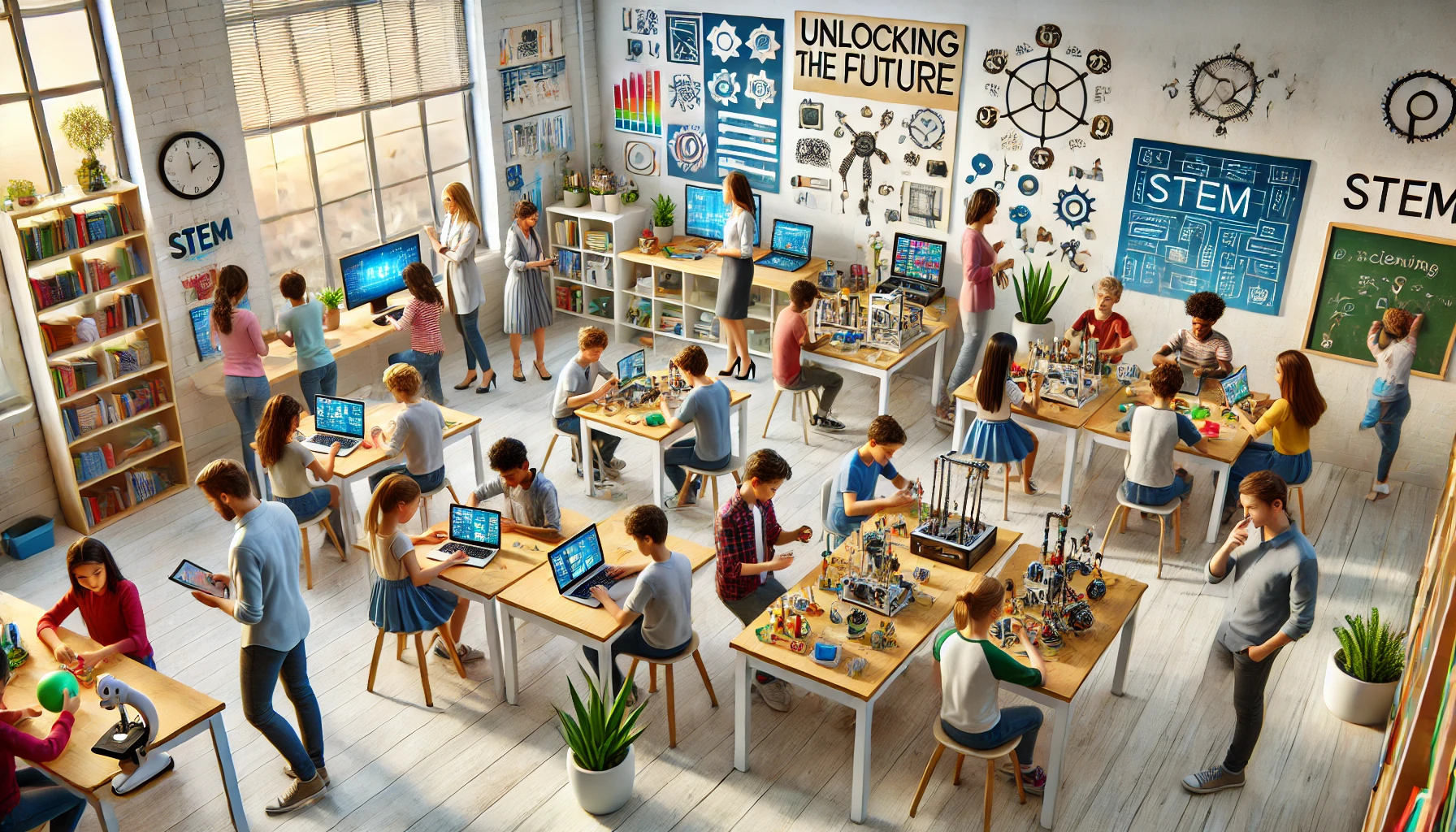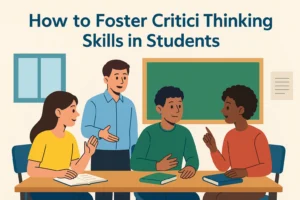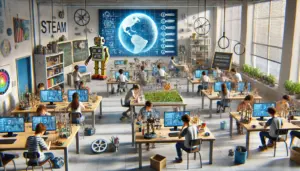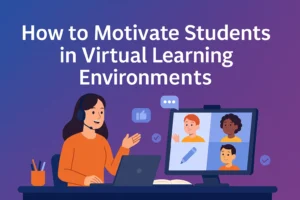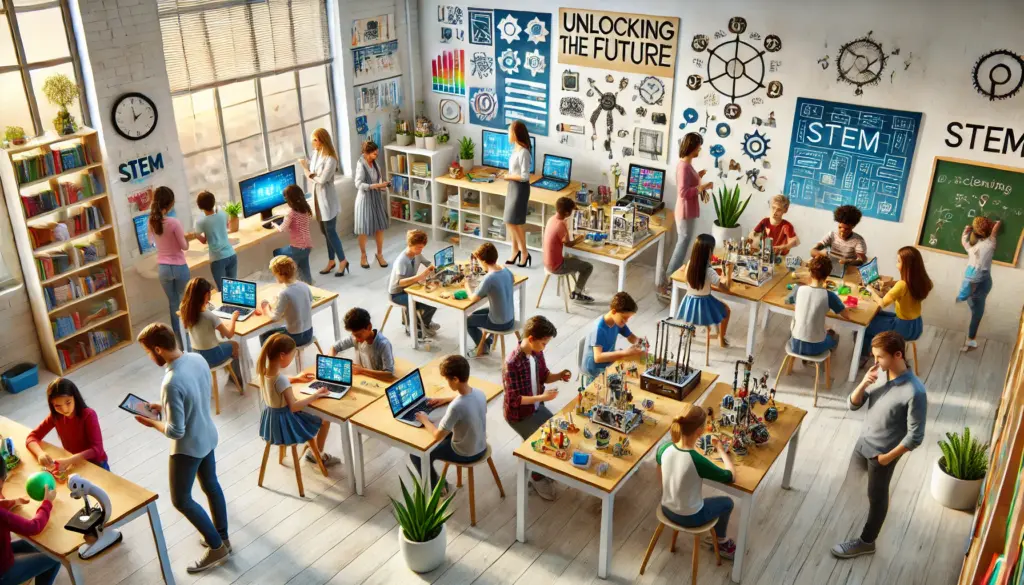
In an age of rapid technological progress and groundbreaking scientific discoveries, the significance of STEM (Science, Technology, Engineering, and Mathematics) education is paramount. Cultivating a new generation of thinkers, innovators, and problem-solvers is essential for navigating and shaping the future. This article delves into innovative STEM education strategies transforming classrooms and inspiring students across the United States.
The Impact of Project-Based Learning
Project-based learning (PBL) stands out as a leading strategy in modern STEM education. By engaging students in real-world problem-solving, PBL allows them to apply theoretical knowledge to practical, hands-on projects. This approach not only enhances the relevance of learning but also fosters critical thinking, collaboration, and communication skills. For example, a project might involve designing a sustainable community garden, integrating concepts from biology, environmental science, and engineering.
Integrating Technology in Education
Leveraging technology is crucial for making STEM subjects more engaging and accessible. Tools like interactive simulations, virtual labs, and coding platforms offer immersive learning experiences. Programs such as Minecraft: Education Edition enable students to build and explore complex structures, promoting creativity and an understanding of engineering principles. Additionally, robotics kits and 3D printers help students bring their ideas to life, bridging the gap between abstract concepts and tangible outcomes.
Introducing STEM Early
Introducing STEM concepts at an early age is vital for developing foundational skills and sparking interest. Early exposure can be achieved through playful learning activities, such as building blocks, simple science experiments, and educational games. Encouraging curiosity and exploration in young learners sets the stage for a lifelong passion for STEM fields.
Interdisciplinary Approaches
STEM education is most effective when integrated with other subjects, creating a holistic learning experience. Interdisciplinary approaches break down the barriers between subjects, illustrating how science, technology, engineering, and mathematics connect with art, history, and literature. For instance, a lesson on ancient civilizations can include engineering concepts used in historical structures and explore the mathematical principles behind them.
Fostering Collaborative Learning
Collaboration is a key element of innovative STEM education. Providing opportunities for students to work in teams mirrors real-world scientific and engineering practices. Collaborative learning environments encourage the exchange of ideas, peer-to-peer teaching, and collective problem-solving. Group projects, team-based challenges, and peer review sessions help students learn from one another and develop essential teamwork skills.
Connecting STEM to Real-World Contexts
Linking STEM learning to real-world contexts enhances its relevance and application. When students see the impact of STEM in their daily lives, they are more likely to be engaged and motivated. Real-world contexts can be introduced through partnerships with local businesses, field trips, and guest speakers from STEM industries. These experiences offer students a deeper understanding of how their learning applies beyond the classroom and can inspire future career aspirations.
The Role of Mentorship and Role Models
Mentorship programs and exposure to role models in STEM fields can significantly influence students’ educational and career paths. Seeing individuals who have succeeded in STEM careers, particularly those from diverse backgrounds, helps students envision themselves in similar roles. Mentors provide guidance, support, and inspiration, assisting students in navigating their STEM journey and overcoming potential obstacles.
Encouraging Inquiry-Based Learning
Inquiry-based learning promotes students to ask questions, conduct research, and seek answers through investigation. This approach mirrors the scientific method and encourages a deeper understanding of scientific concepts. By fostering a culture of curiosity and inquiry, educators help students develop critical thinking skills and a passion for discovery. Classroom activities might include designing experiments, analyzing data, and presenting findings.
Supporting Teacher Professional Development
Ongoing professional development for teachers is essential for effectively implementing innovative STEM education strategies. Educators need to stay current with the latest advancements in STEM fields and pedagogical approaches. Workshops, seminars, and collaborative professional learning communities equip teachers with the knowledge and skills needed to inspire and engage their students. Investing in teacher development ultimately enhances the quality of STEM education.
Creating Inclusive STEM Programs
Ensuring that STEM education is inclusive and accessible to all students is crucial for fostering diversity in STEM fields. Programs should aim to reach underrepresented groups, including girls, minorities, and students with disabilities. Providing equal opportunities and resources helps level the playing field and encourages a broader range of perspectives in STEM innovation. Initiatives such as after-school programs, scholarships, and summer camps play a significant role in promoting inclusivity.
Harnessing Gamification
Gamification incorporates game design elements into educational contexts to enhance learning and motivation. By incorporating challenges, rewards, and interactive elements, gamification makes STEM subjects more engaging and enjoyable. Educational games and apps focusing on problem-solving, coding, and scientific exploration allow students to learn through play. This approach not only makes learning fun but also aids in information retention and the development of critical thinking skills.
Promoting a Growth Mindset
Encouraging a growth mindset—the belief that abilities can be developed through effort and perseverance—is vital in STEM education. Promoting the embrace of challenges, learning from mistakes, and persisting in the face of difficulties helps students develop resilience and a positive attitude towards learning. Educators can foster a growth mindset by providing constructive feedback, celebrating effort and progress, and creating a supportive learning environment.
Supporting Student-Led Learning
Empowering students to take charge of their learning can lead to greater engagement and ownership of their education. Student-led learning involves giving students the freedom to choose projects, set goals, and direct their research. This approach fosters independence, self-motivation, and a deeper connection to the subject matter. Teachers act as facilitators, guiding and supporting students as they navigate their learning journey.
Utilizing Blended Learning Models
Blended learning combines traditional face-to-face instruction with online components, offering a flexible and personalized approach to education. In STEM classrooms, blended learning provides access to a wealth of digital resources, such as video tutorials, interactive simulations, and online assessments. This model allows students to learn at their own pace and receive immediate feedback, enhancing their understanding and retention of STEM concepts.
Incorporating Environmental Education
Integrating environmental education into STEM curricula can raise awareness about sustainability and inspire students to become environmental stewards. Projects focused on renewable energy, conservation, and climate change help students understand the impact of human activities on the planet and explore solutions for a sustainable future. By connecting STEM learning to environmental issues, educators motivate students to apply their knowledge for the greater good.
Cultivating Entrepreneurial Skills
Incorporating entrepreneurship into STEM education encourages students to think creatively and develop innovative solutions to real-world problems. Entrepreneurship programs teach students how to identify opportunities, create business plans, and bring their ideas to market. These skills are essential for future STEM professionals who will navigate an increasingly complex and competitive landscape. Activities such as pitch competitions, hackathons, and start-up incubators provide hands-on experience in entrepreneurship.
Linking STEM to Career Pathways
Helping students see the connection between STEM education and potential career pathways can enhance their motivation and future prospects. Career exploration activities, such as internships, job shadowing, and industry partnerships, offer insights into various STEM professions. Exposure to different career options helps students make informed decisions about their education and career goals, ensuring they are prepared for the demands of the modern workforce.
Incorporating Social and Emotional Learning (SEL)
Social and emotional learning (SEL) focuses on developing skills like self-awareness, empathy, and relationship-building. Integrating SEL into STEM education helps students develop the emotional intelligence needed for collaborative problem-solving and effective communication. Activities promoting teamwork, conflict resolution, and self-reflection enhance the overall learning experience and prepare students for the interpersonal challenges they will face in their careers.
Applying Design Thinking
Design thinking is a problem-solving approach involving empathizing with users, defining problems, ideating solutions, prototyping, and testing. This iterative process encourages creativity and innovation in STEM education. By applying design thinking, students learn to approach challenges from multiple perspectives and develop user-centered solutions. Projects can range from creating assistive devices for people with disabilities to developing sustainable products for environmental conservation.
Promoting Global Collaboration
In today’s interconnected world, global collaboration is essential for addressing complex challenges. STEM education benefits from partnerships with schools, organizations, and experts worldwide. Collaborative projects involving students from different countries offer diverse perspectives and foster cross-cultural understanding. Technology platforms facilitating virtual collaboration, such as video conferencing and online project management tools, enable students to work together on international STEM initiatives.
Supporting Independent Research Projects
Independent research projects allow students to explore their interests in depth and develop expertise in specific STEM areas. By conducting original research, students learn valuable skills in scientific inquiry, data analysis, and presentation. Schools can support independent research by providing resources, mentorship, and opportunities to present findings at science fairs and conferences. Encouraging students to pursue their own research projects can lead to significant discoveries and contributions to the field.
Enhancing Parental and Community Involvement
Engaging parents and the community in STEM education creates a supportive network that enhances student learning. Schools can organize STEM nights, workshops, and community events involving families and local businesses. By fostering a culture of STEM within the community, students receive encouragement and support from multiple sources. Partnerships with local industries and organizations also provide valuable resources and opportunities for students to explore STEM careers.
Conclusion
Innovative STEM education strategies are crucial for preparing students to thrive in a rapidly evolving world. By embracing approaches such as project-based learning, technology integration, interdisciplinary teaching, and real-world applications, educators can inspire and equip students with the skills they need to succeed. As advancements in science and technology continue, it is essential to foster a new generation of innovators and problem-solvers who will shape the future.
FAQs
What are some effective STEM education strategies?
Effective STEM education strategies include project-based learning, technology integration, interdisciplinary teaching, and real-world applications. These approaches engage students, enhance critical thinking, and prepare them for future careers.
How can technology be used in STEM education?
Technology can be used in STEM education through interactive simulations, virtual labs, coding platforms, and robotics kits. These tools provide immersive learning experiences and help students apply theoretical knowledge to practical problems.
Why is early STEM education important?
Early STEM education is important because it builds foundational skills, sparks interest in STEM subjects, and encourages curiosity and exploration. Early exposure helps develop a lifelong passion for science, technology, engineering, and mathematics.
How can educators make STEM learning more relevant to students?
Educators can make STEM learning more relevant by connecting it to real-world contexts, incorporating interdisciplinary approaches, and involving students in hands-on projects. Partnerships with local businesses and field trips can also enhance relevance.
What role do mentors play in STEM education?
Mentors provide guidance, support, and inspiration to students. They help navigate educational and career paths, offer valuable insights, and serve as role models, especially for underrepresented groups in STEM fields.
How can STEM education be made more inclusive?
STEM education can be made more inclusive by designing programs that reach underrepresented groups, providing equal opportunities and resources, and promoting diversity. Initiatives such as scholarships, after-school programs, and mentorship can support inclusivity.
